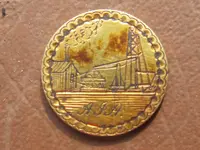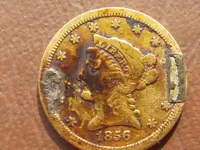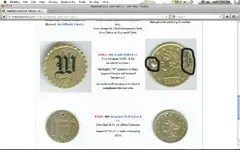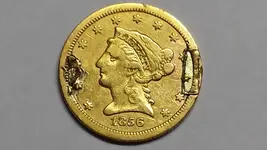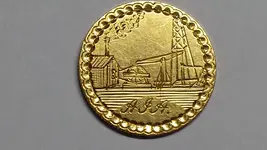You are using an out of date browser. It may not display this or other websites correctly.
You should upgrade or use an alternative browser.
You should upgrade or use an alternative browser.
✅ SOLVED 1856 (First gold, I think...) gold.....what?
- Thread starter Tedyoh
- Start date
AU Seeker
Bronze Member
- Joined
- Oct 14, 2007
- Messages
- 1,554
- Reaction score
- 1,501
- Golden Thread
- 0
- Location
- South Carolina
- Detector(s) used
- E-Track, MXT, CZ6A
- Primary Interest:
- All Treasure Hunting
Bramblefind is fast!!! 



Last edited:
Upvote
0
huntsman53
Gold Member
- Joined
- Jun 11, 2013
- Messages
- 6,955
- Reaction score
- 6,772
- Golden Thread
- 0
- Location
- East Tennessee
- Primary Interest:
- Other
To be honest with you! In it's current condition, the coin will never be worth more than the value of the Gold that it contains! Therefore, it would be my advice, to take the coin to a very competent Jeweler to clean up some of the solder mess on the Obverse and have the coin mounted again as a pendant in the same manner than it was before. This should give the piece a lot more collectibilty than in it's current state and it may fetch a premium if you ever decide to sell it. Before having the Jeweler work done, I would advise to return to the site where the piece was found to see if the pendant setting may have been lost along with the coin. If you do find it, then this may be the piece to use for remounting the coin as a pendant!
Frank
Frank
Upvote
0
huntsman53
Gold Member
- Joined
- Jun 11, 2013
- Messages
- 6,955
- Reaction score
- 6,772
- Golden Thread
- 0
- Location
- East Tennessee
- Primary Interest:
- Other
Well I guess that I was wrong in my statement "In it's current condition, the coin will never be worth more than the value of the Gold that it contains!" based on the the post from Bramblefind!
Frank
Frank
Upvote
0
Tedyoh
Bronze Member
- #24
Thread Owner
To be honest with you! In it's current condition, the coin will never be worth more than the value of the Gold that it contains! Therefore, it would be my advice, to take the coin to a very competent Jeweler to clean up some of the solder mess on the Obverse and have the coin mounted again as a pendant in the same manner than it was before. This should give the piece a lot more collectibilty than in it's current state and it may fetch a premium if you ever decide to sell it. Before having the Jeweler work done, I would advise to return to the site where the piece was found to see if the pendant setting may have been lost along with the coin. If you do find it, then this may be the piece to use for remounting the coin as a pendant!
Frank
Thanks Frank, AU and Bramble.......yes Frank there will be many more trips to this site........we have pulled 5 nice coins from here as well......bad thing is now the grass is high so probably going to wait unit a good frost or two comes and kills off the weeds - also a lot of iron here as well.......what would you think the setting would be made of? So I can dig all of those numbers.......Thanks......
Upvote
0
AU Seeker
Bronze Member
- Joined
- Oct 14, 2007
- Messages
- 1,554
- Reaction score
- 1,501
- Golden Thread
- 0
- Location
- South Carolina
- Detector(s) used
- E-Track, MXT, CZ6A
- Primary Interest:
- All Treasure Hunting
Upvote
0
CC Hunter
Hero Member
Thanks to Everyone for your research and comments.....I just got home from PA so I pulled out the calipers and scale ( only had a tape measure in PA).......the dia. is 19.9 mm on average and the weight is 3.56 grams.......I guess, since the weight is slightly off, it would then make sense that it was a 2.50 gold piece, reverse ground flat then engraved by a jeweler as CC Hunter mentions? Also, does anyone see any problems with a little more cleaning than just rinsing off in the creek when I found it? I would assume not since it's no longer US currency. The more I look at it, the more I like it, and I'm more and more certain I will keep it - but I do wonder if there is any substantial collector value to these Love Tokens? Thanks again to Everyone.....
A diameter measurement of 19.9 mm is rather mysterious, as a Coronet Type $2.50 gold coin should measure 18 mm when newly minted. Taking into account wear and such, the diameter should be slightly less even on a circulated coin. Possibly this particular coin was placed in a press to flatten the surface, thereby increasing the diameter by 10% or so.
Being that this coin/token is in fact 90% gold and quite soft, care should certainly still be exercised in any cleaning methods. Even though numismatic value has long ago been lost, the appeal of the piece as a collectible work of art and skill is worthy of proper handling. A recommendation of a process tried and true, will be one that has been applied many times with success on recovered gold coins by myself and acquaintances.
Items Needed Are:
Cheese Cloth
Cider Vinegar
Distilled Water
Baking Soda
Small Plastic Dish
Small Cooking Pan
Step 1:
Prepare a portion of cheese cloth approximately 6"x6" and carefully place the coin in the center of this. Next lift the cheese cloth by all four corners, creating a cradle for the coin, and then place this inside the plastic dish. Follow by covering the coin with enough cider vinegar to completely immerse all surfaces. Allow this to soak several hours.
Step 2:
Add about a quart of distilled water to the cooking pan, mix in a heaping teaspoon of baking soda, and bring to a boil. Next, take the cheese cloth carefully by all four corners, and remove the coin from the vinegar dish. Immediately dip the coin suspended inside the cheese cloth cradle, into the boiling soda water for a few seconds, taking care not to drop this into the bottom of the pan. Remove the cheese cloth and coin from the boiling soda water, and inspect the results.
If stubborn staining and grime persists, the vinegar soaking process can be repeated, followed by the quick dip in boiling soda water. I've had some gold coins soaking for several days in vinegar, to remove problem staining. This particular gold coin/token shows signs of iron oxide staining, possibly due to the original jewelry item having a steel pin or similar portion.
CC Hunter
Last edited:
Upvote
0
Tedyoh
Bronze Member
- #28
Thread Owner
A diameter measurement of 19.9 mm is rather mysterious, as a Coronet Type $2.50 gold coin should measure 18 mm when newly minted. Taking into account wear and such, the diameter should be slightly less even on a circulated coin. Possibly this particular coin was placed in a press to flatten the surface, thereby increasing the diameter by 10% or so.
Being that this coin/token is in fact 90% gold and quite soft, care should certainly still be exercised in any cleaning methods. Even though numismatic value has long ago been lost, the appeal of the piece as a collectible work of art and skill is worthy of proper handling. A recommendation of a process tried and true, will be one that has been applied many times with success on recovered gold coins by myself and acquaintances.
Items Needed Are:
Cheese Cloth
Cider Vinegar
Distilled Water
Baking Soda
Small Plastic Dish
Small Cooking Pan
Step 1:
Prepare a portion of cheese cloth approximately 6"x6" and carefully place the coin in the center of this. Next lift the cheese cloth by all four corners, creating a cradle for the coin, and then place this inside the plastic dish. Follow by covering the coin with enough cider vinegar to completely immerse all surfaces. Allow this to soak several hours.
Step 2:
Add about a quart of distilled water to the cooking pan, mix in a heaping teaspoon of baking soda, and bring to a boil. Next, take the cheese cloth carefully by all four corners, and remove the coin from the vinegar dish. Immediately dip the coin suspended inside the cheese cloth cradle, into the boiling soda water for a few seconds, taking care not to drop this into the bottom of the pan. Remove the cheese cloth and coin from the boiling soda water, and inspect the results.
If stubborn staining and grime persists, the vinegar soaking process can be repeated, followed by the quick dip in boiling soda water. I've had some gold coins soaking for several days in vinegar, to remove problem staining. This particular gold coin/token shows signs of iron oxide staining, possibly due to the original jewelry item having a steel pin or similar portion.
CC Hunter
Sorry CC - 17.9 mm dia - typo on my part and thanks for the cleaning instructions!
Upvote
0
huntsman53
Gold Member
- Joined
- Jun 11, 2013
- Messages
- 6,955
- Reaction score
- 6,772
- Golden Thread
- 0
- Location
- East Tennessee
- Primary Interest:
- Other
A diameter measurement of 19.9 mm is rather mysterious, as a Coronet Type $2.50 gold coin should measure 18 mm when newly minted. Taking into account wear and such, the diameter should be slightly less even on a circulated coin. Possibly this particular coin was placed in a press to flatten the surface, thereby increasing the diameter by 10% or so.
Being that this coin/token is in fact 90% gold and quite soft, care should certainly still be exercised in any cleaning methods. Even though numismatic value has long ago been lost, the appeal of the piece as a collectible work of art and skill is worthy of proper handling. A recommendation of a process tried and true, will be one that has been applied many times with success on recovered gold coins by myself and acquaintances.
Items Needed Are:
Cheese Cloth
Cider Vinegar
Distilled Water
Baking Soda
Small Plastic Dish
Small Cooking Pan
Step 1:
Prepare a portion of cheese cloth approximately 6"x6" and carefully place the coin in the center of this. Next lift the cheese cloth by all four corners, creating a cradle for the coin, and then place this inside the plastic dish. Follow by covering the coin with enough cider vinegar to completely immerse all surfaces. Allow this to soak several hours.
Step 2:
Add about a quart of distilled water to the cooking pan, mix in a heaping teaspoon of baking soda, and bring to a boil. Next, take the cheese cloth carefully by all four corners, and remove the coin from the vinegar dish. Immediately dip the coin suspended inside the cheese cloth cradle, into the boiling soda water for a few seconds, taking care not to drop this into the bottom of the pan. Remove the cheese cloth and coin from the boiling soda water, and inspect the results.
If stubborn staining and grime persists, the vinegar soaking process can be repeated, followed by the quick dip in boiling soda water. I've had some gold coins soaking for several days in vinegar, to remove problem staining. This particular gold coin/token shows signs of iron oxide staining, possibly due to the original jewelry item having a steel pin or similar portion.
CC Hunter
The O.P. might also try just plain old 91% rubbing alcohol from Walmart or a Drug Store. I have had good success in removing stains by soaking Gold coins in the rubbing alcohol for a few minutes, then lightly rubbing it with a finger or thumb (make sure you don't have rough callus on either) while still wet with alcohol. You may have to repeat a couple of times and I can't be sure that it will remove the (what looks like) burn stains that the coin suffered during the soldering. If they do come off, then dip the coin into the alcohol one more time, rinse with cold water, then pat dry with a soft towel. If the alcohol does not work, then I would recommend trying CC Hunter's method.
Frank
Upvote
0
HutSiteDigger
Silver Member
- Joined
- Nov 26, 2012
- Messages
- 2,849
- Reaction score
- 1,283
- Golden Thread
- 0
- Location
- Stafford,Virginia
- Detector(s) used
- Fisher 1266x and a shovel
- Primary Interest:
- All Treasure Hunting
Upvote
0
CC Hunter
Hero Member
The O.P. might also try just plain old 91% rubbing alcohol from Walmart or a Drug Store. I have had good success in removing stains by soaking Gold coins in the rubbing alcohol for a few minutes, then lightly rubbing it with a finger or thumb (make sure you don't have rough callus on either) while still wet with alcohol. You may have to repeat a couple of times and I can't be sure that it will remove the (what looks like) burn stains that the coin suffered during the soldering. If they do come off, then dip the coin into the alcohol one more time, rinse with cold water, then pat dry with a soft towel. If the alcohol does not work, then I would recommend trying CC Hunter's method.
Frank
Rubbing a gold coin with fingers would hardly be advised, even in a case such as this, where numismatic value has already been greatly compromised. Gold is very soft, and susceptible to scratching with even the slightest touch. The method as I have described, requires no touching of the surface of the coin, and is surely less intrusive. Very likely the redish-brown "staining" on the surface of the coin is the result of being in contact with iron oxides, as I mentioned earlier. Note that there is also slight staining on the engraved side as well. These are not "burn stains" we are seeing from soldering. The soldering was likely done with silver by a skilled jeweler, familiar with the proper steps in working with metals. As such, the finished product would surely not result with anything such as "burning" on the surface of the metals.
Vinegar, being a mild acid, may remove some or all of the staining on this particular gold piece. If the process as I described does not fully remove the staining, then there are options using stronger acids to more specifically attack iron oxides.
With this particular gold coin being uniquely engraved with a nicely detailed scene, apparently of an early oil well operation, the potential collector value is certainly a viable point. The piece is surely worth well above metal melt value, and warrants proper handling.
CC Hunter
Upvote
0
huntsman53
Gold Member
- Joined
- Jun 11, 2013
- Messages
- 6,955
- Reaction score
- 6,772
- Golden Thread
- 0
- Location
- East Tennessee
- Primary Interest:
- Other
Rubbing a gold coin with fingers would hardly be advised, even in a case such as this, where numismatic value has already been greatly compromised. Gold is very soft, and susceptible to scratching with even the slightest touch. The method as I have described, requires no touching of the surface of the coin, and is surely less intrusive. Very likely the redish-brown "staining" on the surface of the coin is the result of being in contact with iron oxides, as I mentioned earlier. Note that there is also slight staining on the engraved side as well. These are not "burn stains" we are seeing from soldering. The soldering was likely done with silver by a skilled jeweler, familiar with the proper steps in working with metals. As such, the finished product would surely not result with anything such as "burning" on the surface of the metals.
Vinegar, being a mild acid, may remove some or all of the staining on this particular gold piece. If the process as I described does not fully remove the staining, then there are options using stronger acids to more specifically attack iron oxides.
With this particular gold coin being uniquely engraved with a nicely detailed scene, apparently of an early oil well operation, the potential collector value is certainly a viable point. The piece is surely worth well above metal melt value, and warrants proper handling.
CC Hunter
I understand and your method would probably be best! I just thought that the alcohol might work as I have removed staining from Gold Coins that were in MS-60 to MS-63 condition and never had a problem with my method. I am all for whatever is best and will not harm the coin in any way!
Frank
Upvote
0
pippinwhitepaws
Banned
- Joined
- Jan 2, 2013
- Messages
- 4,541
- Reaction score
- 1,971
- Golden Thread
- 0
- Location
- somewhere between flagstaff, preskit
- Detector(s) used
- Whites prism III
- Primary Interest:
- Relic Hunting
·1861 Paquet Reverse $20 Liberty gold piece
Upvote
0
- Joined
- Mar 16, 2011
- Messages
- 13,997
- Reaction score
- 16,747
- Golden Thread
- 1
- Location
- San Diego
- 🥇 Banner finds
- 1
- 🏆 Honorable Mentions:
- 3
- Detector(s) used
- Equinox 800/900, Fisher Impulse AQ, E-Trac, 2 Excal 1000's, White's TM808, VibraProbe, 15" NEL Attack, Mi6, Steath 920ix and 720i scoops, TRX, etc....
- Primary Interest:
- All Treasure Hunting
At almost 20mm, the diameter gives me pause. If the rim was flattened for some unknown reason, I guess it could result in making the coin a little bigger. I would think the edge would be a groove instead of being flat. In comparing the found "coin" with the posted known coin, it's obvious that they were not struck by the same obverse die. The point of the hair is much closer to the nearest rosette than the known coin. The ER in liberty is connected in the known coin also and it's not in the found one.
Upvote
0
- Joined
- Mar 16, 2011
- Messages
- 13,997
- Reaction score
- 16,747
- Golden Thread
- 1
- Location
- San Diego
- 🥇 Banner finds
- 1
- 🏆 Honorable Mentions:
- 3
- Detector(s) used
- Equinox 800/900, Fisher Impulse AQ, E-Trac, 2 Excal 1000's, White's TM808, VibraProbe, 15" NEL Attack, Mi6, Steath 920ix and 720i scoops, TRX, etc....
- Primary Interest:
- All Treasure Hunting
Sorry, I didn't see the diameter update.
Upvote
0
kuger
Gold Member
- Joined
- Nov 6, 2007
- Messages
- 9,721
- Reaction score
- 2,798
- Golden Thread
- 0
- Detector(s) used
- ,M.X.T.& Tesoro Tejon
- Primary Interest:
- All Treasure Hunting
Not to beat a dead decaying horse but "rubbing",of ANY coin that may have value....especially gold will definitely hurt your value and you when you see how much!!!To have a coin graded(usually brings the best $$)professionally the coin is put under a microscope(if your lucky and the scratches arent readily seen) and I promise you the scratches will be seen and you will get knocked on your grade...why do that?
Upvote
0
Similar threads
- Question
- Replies
- 26
- Views
- 2K
- Replies
- 10
- Views
- 855
- Question
- Replies
- 2
- Views
- 510
Users who are viewing this thread
Total: 1 (members: 0, guests: 1)

